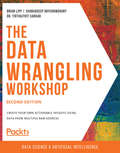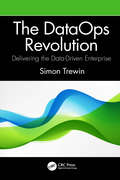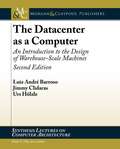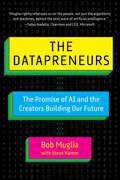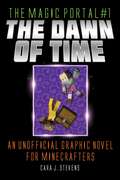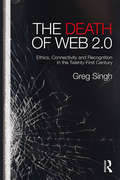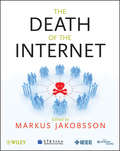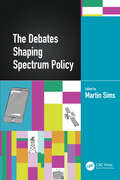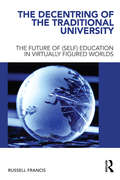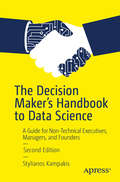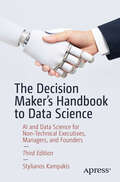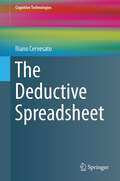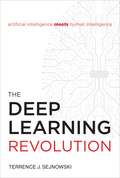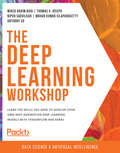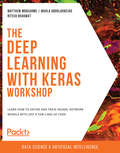- Table View
- List View
The Data Warehouse Toolkit
by Margy Ross Ralph KimballThe latest edition of the single most authoritative guide on dimensional modeling for data warehousing! Dimensional modeling has become the most widely accepted approach for data warehouse design. Here is a complete library of dimensional modeling techniques-- the most comprehensive collection ever written. Greatly expanded to cover both basic and advanced techniques for optimizing data warehouse design, this second edition to Ralph Kimball's classic guide is more than sixty percent updated. The authors begin with fundamental design recommendations and gradually progress step-by-step through increasingly complex scenarios. Clear-cut guidelines for designing dimensional models are illustrated using real-world data warehouse case studies drawn from a variety of business application areas and industries, including: * Retail sales and e-commerce * Inventory management * Procurement * Order management * Customer relationship management (CRM) * Human resources management * Accounting * Financial services * Telecommunications and utilities * Education * Transportation * Health care and insurance By the end of the book, you will have mastered the full range of powerful techniques for designing dimensional databases that are easy to understand and provide fast query response. You will also learn how to create an architected framework that integrates the distributed data warehouse using standardized dimensions and facts. This book is also available as part of the Kimball's Data Warehouse Toolkit Classics Box Set (ISBN: 9780470479575) with the following 3 books: The Data Warehouse Toolkit, 2nd Edition (9780471200246) The Data Warehouse Lifecycle Toolkit, 2nd Edition (9780470149775) The Data Warehouse ETL Toolkit (9780764567575)
The Data WarehouseETL Toolkit
by Ralph Kimball Joe CasertaCowritten by Ralph Kimball, the world's leading data warehousing authority, whose previous books have sold more than 150,000 copiesDelivers real-world solutions for the most time- and labor-intensive portion of data warehousing-data staging, or the extract, transform, load (ETL) processDelineates best practices for extracting data from scattered sources, removing redundant and inaccurate data, transforming the remaining data into correctly formatted data structures, and then loading the end product into the data warehouseOffers proven time-saving ETL techniques, comprehensive guidance on building dimensional structures, and crucial advice on ensuring data quality
The Data Wrangling Workshop: Create your own actionable insights using data from multiple raw sources, 2nd Edition
by Shubhadeep Roychowdhury Brian Lipp Dr. Tirthajyoti SarkarA beginner's guide to simplifying Extract, Transform, Load (ETL) processes with the help of hands-on tips, tricks, and best practices, in a fun and interactive way Key Features Explore data wrangling with the help of real-world examples and business use cases Study various ways to extract the most value from your data in minimal time Boost your knowledge with bonus topics, such as random data generation and data integrity checks Book Description While a huge amount of data is readily available to us, it is not useful in its raw form. For data to be meaningful, it must be curated and refined. If you're a beginner, then The Data Wrangling Workshop will help to break down the process for you. You'll start with the basics and build your knowledge, progressing from the core aspects behind data wrangling, to using the most popular tools and techniques. This book starts by showing you how to work with data structures using Python. Through examples and activities, you'll understand why you should stay away from traditional methods of data cleaning used in other languages and take advantage of the specialized pre-built routines in Python. Later, you'll learn how to use the same Python backend to extract and transform data from an array of sources, including the internet, large database vaults, and Excel financial tables. To help you prepare for more challenging scenarios, the book teaches you how to handle missing or incorrect data, and reformat it based on the requirements from your downstream analytics tool. By the end of this book, you will have developed a solid understanding of how to perform data wrangling with Python, and learned several techniques and best practices to extract, clean, transform, and format your data efficiently, from a diverse array of sources. What you will learn Get to grips with the fundamentals of data wrangling Understand how to model data with random data generation and data integrity checks Discover how to examine data with descriptive statistics and plotting techniques Explore how to search and retrieve information with regular expressions Delve into commonly-used Python data science libraries Become well-versed with how to handle and compensate for missing data Who this book is for The Data Wrangling Workshop is designed for developers, data analysts, and business analysts who are looking to pursue a career as a full-fledged data scientist or analytics expert. Although this book is for beginners who want to start data wrangling, prior working knowledge of the Python programming language is necessary to easily grasp the concepts covered here. It will also help to have a rudimentary knowledge of relational databases and SQL.
The Data-Driven Blockchain Ecosystem: Fundamentals, Applications, and Emerging Technologies
by Seema Sharma Alex Khang Subrata ChowdhuryThis book focuses on futuristic approaches and designs for real-time systems and applications, as well as the fundamental concepts of including advanced techniques and tools in models of data-driven blockchain ecosystems. The Data-Driven Blockchain Ecosystem: Fundamentals, Applications, and Emerging Technologies discusses how to implement and manage processes for releasing and delivering blockchain applications. It presents the core of blockchain technology, IoT-based and AI-based blockchain systems, and various manufacturing areas related to Industry 4.0. The book illustrates how to apply design principles to develop and manage blockchain networks, and also covers the role that cloud computing plays in blockchain applications. All major technologies involved in blockchain-embedded applications are included in this book, which makes it useful to engineering students, researchers, academicians, and professionals interested in the core of blockchain technology.
The Data-driven Organization: Using Data for the Success of Your Company (Business Guides on the Go)
by Jonas RashediData has become an indispensable success factor for every company. However, the road towards a data-driven organization is paved with numerous challenges. This book presents a process model for the path to a data-driven company and provides recommendations for the design of all relevant fields of action: Which structures need to be created? Which systems and processes have proven beneficial? How can the quality of the data be ensured and what requirements exist for a data-driven organization in the areas of governance and communication? And last but not least: How can employees be brought along on the journey and what implications does the data-driven organization have for our corporate culture? The book presents an orientation and action framework for the strategic and operational design of a data-driven organization and is valuable for managers who are involved in data management in companies and organizations.
The DataOps Revolution: Delivering the Data-Driven Enterprise
by Simon TrewinDataOps is a new way of delivering data and analytics that is proven to get results. It enables IT and users to collaborate in the delivery of solutions that help organisations to embrace a data-driven culture. The DataOps Revolution: Delivering the Data-Driven Enterprise is a narrative about real world issues involved in using DataOps to make data-driven decisions in modern organisations. The book is built around real delivery examples based on the author’s own experience and lays out principles and a methodology for business success using DataOps. Presenting practical design patterns and DataOps approaches, the book shows how DataOps projects are run and presents the benefits of using DataOps to implement data solutions. Best practices are introduced in this book through the telling of a story, which relates how a lead manager must find a way through complexity to turn an organisation around. This narrative vividly illustrates DataOps in action, enabling readers to incorporate best practices into everyday projects. The book tells the story of an embattled CIO who turns to a new and untested project manager charged with a wide remit to roll out DataOps techniques to an entire organisation. It illustrates a different approach to addressing the challenges in bridging the gap between IT and the business. The approach presented in this story lines up to the six IMPACT pillars of the DataOps model that Kinaesis (www.kinaesis.com) has been using through its consultants to deliver successful projects and turn around failing deliveries. The pillars help to organise thinking and structure an approach to project delivery. The pillars are broken down and translated into steps that can be applied to real-world projects that can deliver satisfaction and fulfillment to customers and project team members.
The Datacenter as a Computer: An Introduction to the Design of Warehouse-Scale Machines (Second Edition) (Synthesis Lectures on Computer Architecture #Lecture #24)
by Luiz Andre Barroso Jimmy Clidaras Urs HolzleAs computation continues to move into the cloud, the computing platform of interest no longer resembles a pizza box or a refrigerator, but a warehouse full of computers. <p>These new large datacenters are quite different from traditional hosting facilities of earlier times and cannot be viewed simply as a collection of co-located servers. <p><p>Large portions of the hardware and software resources in these facilities must work in concert to efficiently deliver good levels of Internet service performance, something that can only be achieved by a holistic approach to their design and deployment. <p>The first major update to this lecture is presented after nearly four years of substantial academic and industrial developments in warehouse-scale computing.
The Datapreneurs: The Promise of AI and the Creators Building Our Future
by Steve Hamm Bob MugliaA leader in the data economy explains how we arrived at AI—and how we can navigate its future In The Datapreneurs, Bob Muglia helps us understand how innovation in data and information technology have led us to AI—and how this technology must shape our future. The long-time Microsoft executive, former CEO of Snowflake, and current tech investor maps the evolution of the modern data stack and how it has helped build today&’s economy and society. And he explains how humanity must create a new social contract for the artificial general intelligence (AGI)—autonomous machines intelligent as people—that he expects to arrive in less than a decade. Muglia details his personal experience in the foundational years of computing and data analytics, including with Bill Gates and Sam Altman, the CEO of OpenAI, the creator of ChatGPT, and others that are not household names—yet. He builds upon Isaac Asimov&’s Laws of Robotics to explore the moral, ethical, and legal implications of today&’s smart machines, and how a combination of human and machine intelligence could create an era of progress and prosperity where all the people on Earth can have what they need and want without destroying our natural environment.The Datapreneurs is a call to action. AGI is surely coming. Muglia believes that tech business leaders, ethicists, policy leaders, and even the general public must collaborate answer the short- and long-term questions raised by its emergence. And he argues that we had better get going, because advances are coming so fast that society risks getting caught flatfooted—with potentially disastrous consequences.
The Dawn of Time: An Unofficial Graphic Novel for Minecrafters (The Magic Portal #1)
by Cara J. StevensThe first book in an all-new graphic novel series for Minecrafters—The Magic Portal! In a world where combat games are the key to survival, two rivals get accidentally sucked into a portal that brings them back in time to the very beginning of The End. There, they uncover the ancient secrets of an Enderman&’s unusual behavior. In order to get back home and share this valuable knowledge, Keri and Omar must guide the Endermen to carry out their plan to build the End Portal. The problem is, the Endermen aren&’t so keen on following the plans Keri and Omar have laid out for them. In fact, if they&’re not careful, they&’ll find out just how hostile an Enderman can get. Will Keri learn to trust Omar? Can these two enemies find a way to get along long enough to hatch a plan, convince the Endermen to build the End Portal, and return home without making any waves in their future timeline?
The Death of Truth: How Social Media and the Internet Gave Snake Oil Salesmen and Demagogues the Weapons They Needed to Destroy Trust and Polarize the World--And What We Can Do
by Steven BrillHow did we become a world where facts—shared truths—have lost their power to hold us together as a community, as a country, globally? How have we allowed the proliferation of alternative facts, hoaxes, even conspiracy theories, to destroy our trust in institutions, leaders, and legitimate experts? Best-selling journalist Steven Brill documents the forces and people, from Silicon Valley to Madison Avenue to Moscow to Washington, that have created and exploited this world of chaos and division—and offers practical solutions for what we can do about it."A precise description of the punishment cell we have built around our minds and the first few steps back towards light and air." –Timothy Snyder, Author of On Tyranny and Professor of History, Yale University&“A seminal, ground-breaking, documented and honest examination of two of the central dilemmas of our time—what is truth and where to find it.&” —Bob Woodward, associate editor at The Washington PostAs the cofounder of NewsGuard, a company that tracks online misinformation, Steven Brill has observed the rise of fake news from a front-row seat. In The Death of Truth, with startling, often terrifying clarity, he explains how we got here—and how we can get back to a world where truth matters.None of this—conspiracy theories embraced, expertise ridiculed, empirical evidence ignored—has happened by accident. Brill takes us inside the decisions made by executives in Silicon Valley to code the algorithms embedded in their social media platforms to maximize profits by pushing divisive content. He unravels the ingenious creation of automated advertising buying systems that reward that click-baiting content and penalize reliable news publishers, and describes how the use of these ad-financed, misinformation platforms by politicians, hucksters, and conspiracy theorists deceives ordinary citizens. He documents how the most powerful adversaries of America have used American-made social media and advertising tools against us with massive disinformation campaigns—and how, with the development of generative artificial intelligence, everything could get exponentially worse unless we act. The stakes are high for all of us, including Brill himself, whose company's role in exposing Russian disinformation operations resulted in a Russian agent targeting him and his family.Crucially, Brill lays out a series of provocative but realistic prescriptions for what we can do now to reverse course—proposals certain to stir debate and even action that could curb the power of big tech to profit from division and chaos, tamp down polarization, and restore the trust necessary to bring us together.
The Death of Web 2.0: Ethics, Connectivity and Recognition in the Twenty-First Century
by Greg SinghWith all our contemporary connectivity, are we really connected? What does the nature of connectivity tell us about interpersonal and community relationships? What ethical concerns are raised through an always-on culture? Communication in today’s world is characterised by a condition of persistent, semi-permanent connectivity, which seems to bring us closer together, but which can also be profoundly alienating. The Death of Web 2.0 takes a retrospective look at a moment in recent media history that has had, and will continue to have, a lasting impact upon the predominant attitude towards cultures of connectivity. Greg Singh draws from a range of approaches, intellectual traditions and scholarly disciplines to engage key questions underpinning the contemporary communications media ecosystem. Bringing together influences from communitarian ethics, recognition theory and relational and depth psychology, Singh synthesises key approaches to produce a critical inquiry that projects the tensions at the heart of connectivity as a principle of Web 2.0. He argues that Web 2.0 is a cultural moment that is truly over, and that what is popularly described as 'Web 2.0' is an altogether different set of principles and practices. The Death of Web 2.0 recognises the consequences of our 'always-on' culture, where judgments are made quickly and where impacts can be far-reaching, affecting our relationships, wellbeing, mental health and the health of our communities, and it concludes by asking what an ethics of connectivity would look like. This unique interdisciplinary work will be essential reading for academics and students of Jungian and post-Jungian studies, media and cultural studies and psychosocial studies as well as anyone interested in the social implications of new media.
The Death of the Internet
by Markus JakobssonFraud poses a significant threat to the Internet. 1.5% of all online advertisements attempt to spread malware. This lowers the willingness to view or handle advertisements, which will severely affect the structure of the web and its viability. It may also destabilize online commerce. In addition, the Internet is increasingly becoming a weapon for political targets by malicious organizations and governments. This book will examine these and related topics, such as smart phone based web security. This book describes the basic threats to the Internet (loss of trust, loss of advertising revenue, loss of security) and how they are related. It also discusses the primary countermeasures and how to implement them.
The Debates Shaping Spectrum Policy
by Martin SimsWhat debates have caused spectrum policy to change course and which will determine its future direction? This book examines these issues through a series of chapters from a range of notable experts. The backdrop is a period of turbulent change in what was once a quiet backwater. The past quarter century has seen wireless connectivity go from nice-to-have luxury to the cornerstone of success as nations battle for leadership of the digital economy. The change has been reflected in the crucial role now played by market's mechanisms in a field once dominated by administrative decisions. Spectrum policy’s goals have moved far beyond the efficient use of the airwaves to include encouraging economic development, investment, innovation, sustainability and digital inclusivity. Are historic procedures still appropriate in the face of this multiplicity of demands? Are market mechanisms like auctions still the best way to deliver what has become essential infrastructure? Does the process of international coordination need to change? Is spectrum policy’s effectiveness limited by the power of global economic forces? Can it reduce rather than add to global warming? Where does 6G and AI fit in? Is public perception the new spectrum policy battle ground? These are all issues examined in The Debates Shaping Spectrum Policy.
The Debugger's Handbook
by J.F. DiMarzioFor today's programmers, it is impossible to foresee every input, every usage scenario, and every combination of applications that can cause errors when run simultaneously. Given all of these unknowns, writing absolutely bug-free code is unachievable. But it is possible, with the right knowledge, to produce nearly bug-free code and The Debugger's H
The Decentring of the Traditional University: The Future of (Self) Education in Virtually Figured Worlds
by Russell FrancisThe Decentring of the Traditional University provides a unique perspective on the implications of media change for learning and literacy that allows us to peer into the future of (self) education. Each chapter draws on socio-cultural and activity theory to investigate how resourceful students are breaking away from traditional modes of instruction and educating themselves through engagement with a globally interconnected web-based participatory culture. The argument is developed with reference to the findings of an ethnographic study that focused on university students’ informal uses of social and participatory media. Each chapter draws attention to the shifting locus of agency for regulating and managing learning and describes an emergent genre of learning activity. For example, Francis explores how students are cultivating and nurturing globally distributed funds of living knowledge that transcend institutional boundaries and describes students learning through serious play in virtually figured worlds that support radically personalised lifelong learning agendas. These stories also highlight the challenges and choices learners confront as they struggle to negotiate the faultlines of media convergence and master the new media literacies required to exploit the full potential of Web 2.0 as a learning resource. Overall, this compelling argument proposes that we are witnessing a period of historic systemic change in the culture of university learning as an emergent web-based participatory culture starts to disrupt and displace a top-down culture industry model of education that has evolved around the medium of the book. As a result, Francis argues that we need to re-conceive higher education as an identity-project in which students work on their projective identities (or imagined future selves) through engagement with both formal and informal learning activities.
The Decision Intelligence Handbook: Practical Steps for Evidence-Based Decisions in a Complex World
by L. Y. Pratt N. E. MalcolmDecision intelligence (DI) has been widely named as a top technology trend for several years, and Gartner reports that more than a third of large organizations are adopting it. Some even say that DI is the next step in the evolution of AI. Many software vendors offer DI solutions today, as they help organizations implement their evidence-based or data-driven decision strategies.But until now, there has been little practical guidance for organizations to formalize decision making and integrate their decisions with data.With this book, authors L. Y. Pratt and N. E. Malcolm fill this gap. They present a step-by-step method for integrating technology into decisions that bridge from actions to desired outcomes, with a focus on systems that act in an advisory, human-in-the-loop capacity to decision makers.This handbook addresses three widespread data-driven decision-making problems:How can decision makers use data and technology to ensure desired outcomes?How can technology teams communicate effectively with decision makers to maximize the return on their data and technology investments?How can organizational decision makers assess and improve their decisions over time?
The Decision Maker's Handbook to Data Science: A Guide for Non-Technical Executives, Managers, and Founders
by Stylianos KampakisData science is expanding across industries at a rapid pace, and the companies first to adopt best practices will gain a significant advantage. To reap the benefits, decision makers need to have a confident understanding of data science and its application in their organization. It is easy for novices to the subject to feel paralyzed by intimidating buzzwords, but what many don’t realize is that data science is in fact quite multidisciplinary—useful in the hands of business analysts, communications strategists, designers, and more.With the second edition of The Decision Maker’s Handbook to Data Science, you will learn how to think like a veteran data scientist and approach solutions to business problems in an entirely new way. Author Stylianos Kampakis provides you with the expertise and tools required to develop a solid data strategy that is continuously effective. Ethics and legal issues surrounding data collection and algorithmic bias are some common pitfalls that Kampakis helps you avoid, while guiding you on the path to build a thriving data science culture at your organization. This updated and revised second edition, includes plenty of case studies, tools for project assessment, and expanded content for hiring and managing data scientists Data science is a language that everyone at a modern company should understand across departments. Friction in communication arises most often when management does not connect with what a data scientist is doing or how impactful data collection and storage can be for their organization. The Decision Maker’s Handbook to Data Science bridges this gap and readies you for both the present and future of your workplace in this engaging, comprehensive guide.What You Will LearnUnderstand how data science can be used within your business.Recognize the differences between AI, machine learning, and statistics.Become skilled at thinking like a data scientist, without being one.Discover how to hire and manage data scientists.Comprehend how to build the right environment in order to make your organization data-driven. Who This Book Is For Startup founders, product managers, higher level managers, and any other non-technical decision makers who are thinking to implement data science in their organization and hire data scientists. A secondary audience includes people looking for a soft introduction into the subject of data science.
The Decision Maker's Handbook to Data Science: AI and Data Science for Non-Technical Executives, Managers, and Founders
by Stylianos KampakisData science is expanding across industries at a rapid pace, and the companies first to adopt best practices will gain a significant advantage. To reap the benefits, decision makers need to have a confident understanding of data science and its application in their organization. This third edition delves into the latest advancements in AI, particularly focusing on large language models (LLMs), with clear distinctions made between AI and traditional data science, including AI's ability to emulate human decision-making. Author Stylianos Kampakis introduces you to the critical aspect of ethics in AI, an area of growing importance and scrutiny. The narrative examines the ethical considerations intrinsic to the development and deployment of AI technologies, including bias, fairness, transparency, and accountability. You’ll be provided with the expertise and tools required to develop a solid data strategy that is continuously effective. Ethics and legal issues surrounding data collection and algorithmic bias are some common pitfalls that Kampakis helps you avoid, while guiding you on the path to build a thriving data science culture at your organization. This updated edition also includes plenty of case studies, tools for project assessment, and expanded content for hiring and managing data scientists. Data science is a language that everyone at a modern company should understand across departments. Friction in communication arises most often when management does not connect with what a data scientist is doing or how impactful data collection and storage can be for their organization. The Decision Maker’s Handbook to Data Science bridges this gap and readies you for both the present and future of your workplace in this engaging, comprehensive guide. What You Will Learn Integrate AI with other innovative technologies Explore anticipated ethical, regulatory, and technical landscapes that will shape the future of AI and data scienceDiscover how to hire and manage data scientistsBuild the right environment in order to make your organization data-driven Who This Book Is For Startup founders, product managers, higher level managers, and any other non-technical decision makers who are thinking to implement data science in their organization and hire data scientists. A secondary audience includes people looking for a soft introduction into the subject of data science.
The Decision Model: A Business Logic Framework Linking Business and Technology
by Barbara von Halle Larry GoldbergIn the current fast-paced and constantly changing business environment, it is more important than ever for organizations to be agile, monitor business performance, and meet with increasingly stringent compliance requirements. Written by pioneering consultants and bestselling authors with track records of international success, The Decision Model: A
The Deductive Spreadsheet
by Iliano CervesatoThis book describes recent multidisciplinary research at the confluence of the fields of logic programming, database theory and human-computer interaction. The goal of this effort was to develop the basis of a deductive spreadsheet, a user productivity application that allows users without formal training in computer science to make decisions about generic data in the same simple way they currently use spreadsheets to make decisions about numerical data. The result is an elegant design supported by the most recent developments in the above disciplines. The first half of the book focuses on the deductive engine that underlies this application, the foundations that users do not see. After giving a mathematical model of traditional spreadsheet applications, we extend them with operators to perform a number of relational tasks, similar to the user view of a database but in a spreadsheet context. Expressing this extension in a logic programming framework is a natural step towards giving it powerful deductive capabilities. The second half of the book deals with the user interface, the part of the application with which the user actually interacts. We review the elements of the graphical user interface of traditional spreadsheet applications and describe practical methodologies for designing user interfaces borrowed from the field of cognitive psychology. We then propose a design that conservatively integrates mechanisms for a user to take advantage of the new deductive capabilities. This is followed by the results of some preliminary usability experiments. The book will appeal to researchers and practitioners in the various areas underlying this work. Researchers will not only find interesting new developments in their domains, but will also learn how to achieve a multidisciplinary focus. Practitioners will find fully developed solutions to numerous problems that are not easily solvable using traditional spreadsheet applications.
The Deep Learning Revolution
by Terrence J. SejnowskiSejnowski played an important role in the founding of deep learning, as one of a small group of researchers in the 1980s who challenged the prevailing logic-and-symbol based version of AI. The new version of AI Sejnowski and others developed, which became deep learning, is fueled instead by data..
The Deep Learning Revolution (The\mit Press Ser.)
by Terrence J. SejnowskiHow deep learning—from Google Translate to driverless cars to personal cognitive assistants—is changing our lives and transforming every sector of the economy.The deep learning revolution has brought us driverless cars, the greatly improved Google Translate, fluent conversations with Siri and Alexa, and enormous profits from automated trading on the New York Stock Exchange. Deep learning networks can play poker better than professional poker players and defeat a world champion at Go. In this book, Terry Sejnowski explains how deep learning went from being an arcane academic field to a disruptive technology in the information economy.Sejnowski played an important role in the founding of deep learning, as one of a small group of researchers in the 1980s who challenged the prevailing logic-and-symbol based version of AI. The new version of AI Sejnowski and others developed, which became deep learning, is fueled instead by data. Deep networks learn from data in the same way that babies experience the world, starting with fresh eyes and gradually acquiring the skills needed to navigate novel environments. Learning algorithms extract information from raw data; information can be used to create knowledge; knowledge underlies understanding; understanding leads to wisdom. Someday a driverless car will know the road better than you do and drive with more skill; a deep learning network will diagnose your illness; a personal cognitive assistant will augment your puny human brain. It took nature many millions of years to evolve human intelligence; AI is on a trajectory measured in decades. Sejnowski prepares us for a deep learning future.
The Deep Learning Workshop: Learn the skills you need to develop your own next-generation deep learning models with TensorFlow and Keras
by Anthony So Thomas V. Joseph Mirza Rahim Baig Nipun Sadvilkar Mohan Kumar SilaparasettyTake a hands-on approach to understanding deep learning and build smart applications that can recognize images and interpret text Key Features Understand how to implement deep learning with TensorFlow and Keras Learn the fundamentals of computer vision and image recognition Study the architecture of different neural networks Book Description Are you fascinated by how deep learning powers intelligent applications such as self-driving cars, virtual assistants, facial recognition devices, and chatbots to process data and solve complex problems? Whether you are familiar with machine learning or are new to this domain, The Deep Learning Workshop will make it easy for you to understand deep learning with the help of interesting examples and exercises throughout. The book starts by highlighting the relationship between deep learning, machine learning, and artificial intelligence and helps you get comfortable with the TensorFlow 2.0 programming structure using hands-on exercises. You'll understand neural networks, the structure of a perceptron, and how to use TensorFlow to create and train models. The book will then let you explore the fundamentals of computer vision by performing image recognition exercises with convolutional neural networks (CNNs) using Keras. As you advance, you'll be able to make your model more powerful by implementing text embedding and sequencing the data using popular deep learning solutions. Finally, you'll get to grips with bidirectional recurrent neural networks (RNNs) and build generative adversarial networks (GANs) for image synthesis. By the end of this deep learning book, you'll have learned the skills essential for building deep learning models with TensorFlow and Keras. What you will learn Understand how deep learning, machine learning, and artificial intelligence are different Develop multilayer deep neural networks with TensorFlow Implement deep neural networks for multiclass classification using Keras Train CNN models for image recognition Handle sequence data and use it in conjunction with RNNs Build a GAN to generate high-quality synthesized images Who this book is for If you are interested in machine learning and want to create and train deep learning models using TensorFlow and Keras, this workshop is for you. A solid understanding of Python and its packages, along with basic machine learning concepts, will help you to learn the topics quickly.
The Deep Learning with Keras Workshop - Third Edition: Solve Complex Real-life Problems With The Simplicity Of Keras
by Mahla Abdolahnejad Matthew MoocarmeIf you know the basics of data science and machine learning, and want to get started with advanced machine learning technologies, such as artificial neural networks and deep learning, this workshop makes it easy. To grasp the concepts explained in this deep learning book more effectively, prior experience in Python programming and some familiarity with statistics and logistic regression are a must.
The Deep Learning with Keras Workshop: An Interactive Approach to Understanding Deep Learning with Keras, 2nd Edition
by Ritesh Bhagwat Mahla Abdolahnejad Matthew MoocarmeCut through the noise and get real results with a step-by-step approach to understanding deep learning with Keras programming Key Features Ideal for those getting started with Keras for the first time A step-by-step Keras tutorial with exercises and activities that help build key skills Structured to let you progress at your own pace, on your own terms Use your physical print copy to redeem free access to the online interactive edition Book Description You already know that you want to learn Keras, and a smarter way to learn is to learn by doing. The Deep Learning with Keras Workshop focuses on building up your practical skills so that you can develop artificial intelligence applications or build machine learning models with Keras. You'll learn from real examples that lead to real results. Throughout The Deep Learning with Keras Workshop, you'll take an engaging step-by-step approach to understand Keras. You won't have to sit through any unnecessary theory. If you're short on time you can jump into a single exercise each day or spend an entire weekend tinkering with your own neural networks. It's your choice. Learning on your terms, you'll build up and reinforce key skills in a way that feels rewarding. Every physical print copy of The Deep Learning with Keras Workshop unlocks access to the interactive edition. With videos detailing all exercises and activities, you'll always have a guided solution. You can also benchmark yourself against assessments, track progress, and receive content updates. You'll even earn a secure credential that you can share and verify online upon completion. It's a premium learning experience that's included with your printed copy. To redeem, follow the instructions located at the start of your book. Fast-paced and direct, The Deep Learning with Keras Workshop is the ideal companion for those who are just getting started with Keras. You'll build and iterate on your code like a software developer, learning along the way. This process means that you'll find that your new skills stick, embedded as best practice. A solid foundation for the years ahead. What you will learn Gain insight into the fundamental concepts of neural networks Learn to think like a data scientist and understand the difference between machine learning and deep learning Discover various techniques to evaluate, tweak, and improve your models Explore different techniques to manipulate your data Explore alternative techniques to verify the accuracy of your model Who this book is for Our goal at Packt is to help you be successful, in whatever it is that you choose to do. The Deep Learning with Keras Workshop is an ideal tutorial for the programmer who is getting started with Keras and deep learning. Pick up a Workshop today and let Packt help you develop skills that stick with you for life.


